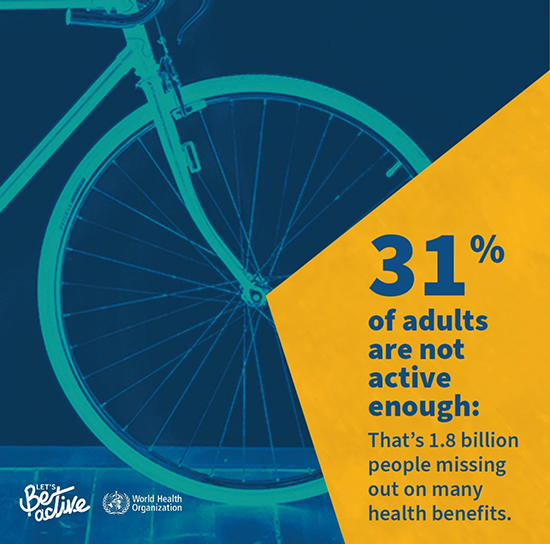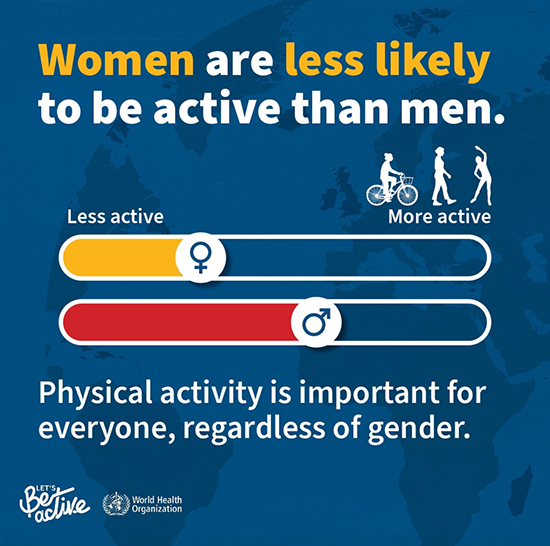Lack of physical activity worsens globally: 39.7% Filipinos not active enough
The World Health Organization (WHO) organized a press briefing a few weeks ago to update the public regarding new data gathered on levels of physical inactivity worldwide. The findings were published in The Lancet Global Health Journal online by the research team from WHO and its academic partners.
The press briefing was conducted by WHO officers including Dr. Ruediger Kerch, director for Health Promotion; Dr. Fiona Bull, head of physical activity unit; and Dr. Leanne Riley, head of surveillance, monitoring and reporting, non-communicable diseases department.
The new data revealed that the level of inactivity has increased from 26% to 31% from 2010 to 2022. That is equivalent to 1.8 billion people worldwide. WHO projects that the percentage will rise to 35% by 2030. The global plan was to reduce the ratio of physically inactive people by then.

The bad news is that Filipinos already overtook that as we registered 39.7% of the population with insufficient physical activity. We are listed as one of the countries with the highest prevalence of insufficient physical activity after Kuwait (67%) and Serbia (39.5%). WHO prescribes 150 minutes of moderate-intensity or 75 minutes of vigorous-intensity movement per week. Failure to meet this physical activity number increases the risk of heart attacks, strokes, type 2 diabetes, dementia, and cancer.
Physical inactivity is a silent threat to global health, contributing significantly to the burden of chronic diseases, says Dr Rüdiger Krech, director of Health Promotion at WHO.
“These new findings highlight a lost opportunity to reduce cancer and heart disease, and improve mental health and well-being through increased physical activity,” said Dr Tedros Adhanom Ghebreyesus, WHO director general. “We must renew our commitment to increasing levels of physical activity and prioritizing bold action, including strengthened policies and increased funding, to reverse this worrying trend.”
The highest rates of physical inactivity were observed in the high-income Asia Pacific region (48%) and South Asia (45%), with levels of inactivity in other regions ranging from 28% in high-income Western countries to 14% in Oceania.

Insufficient movement is most prevalent in women whose global average is 34% compared to 29% in men. In general, those over 60 years old are also less active which makes physical activity promotion to this age group vital.
“Physical inactivity is a silent threat to global health, contributing significantly to the burden of chronic diseases,” said Dr Rüdiger Krech, director of Health Promotion at WHO. “We need to find innovative ways to motivate people to be more active, considering factors like age, environment, and cultural background. By making physical activity accessible, affordable, and enjoyable for all, we can significantly reduce the risk of non-communicable diseases and create a population that is healthier and more productive.”

Around 22 countries were identified as being on track in reducing the inactivity levels by 15% by 2030. The list of top countries with a high percentage of their population achieving sufficient physical activity include China (86%), Russia (82.5%), US (73.8%), Chile (73.5%), Netherlands (73%), Spain (73%), Sweden (76.5%), Canada (71.5%), France (71%), Mexico (71%), Turkey (69.5%), and Australia (69.5%).
“Promoting physical activity goes beyond promoting individual lifestyle choice—it will require a whole-of-society approach and creating environments that make it easier and safer for everyone to be more active in ways they enjoy to reap the many health benefits of regular physical activity,” said Dr. Fiona Bull, head of the WHO unit for physical activity.
Sedentary behavior includes sitting, reclining or lying. The use of vehicles and the dominant use of screens at work and at home have perpetrated immobility. Experts say that people who are insufficiently active have a 20 to 30% increased risk of premature death.

Be aware that there are certain age and gender differences in meeting the minimum number of hours of moderate activity. Women are less mobile than men by about five percent, a figure that has remained unchanged for 24 years. After 60, level of activity (whether male or female) lessens. A whopping 81 percent of adolescents (11-17 years old) are physically inactive. A high 85% of adolescent girls vs. 78% of adolescent boys were physically inactive.
The family is society’s smallest unit and positive changes should start there. Be creative in incorporating more physical activities as a family. Organize 30-minute walks after dinner, including even the household staff and dogs. Learn a fast dance and maybe even film a family TikTok. Get into a sport the whole family can play on weekends. Organize general cleaning of the whole house, weekend car wash, or let the whole family tend the garden. Hit the gym to lift weights regularly; you can even train as a family under one fitness coach. Walk to the village pantry or church. Why drive to a place you can reach on foot in 20 minutes? Take the stairs instead of the escalators and elevators in buildings and malls. Park farthest from the building entrance so you can add daily steps to your pedometer.
It’s quite easy to fall into the comfortable trap of being glued to our screens, but let’s make a conscious effort as a nation to take charge of increasing our family’s physical activities of at least 150 minutes of moderate exercise.



